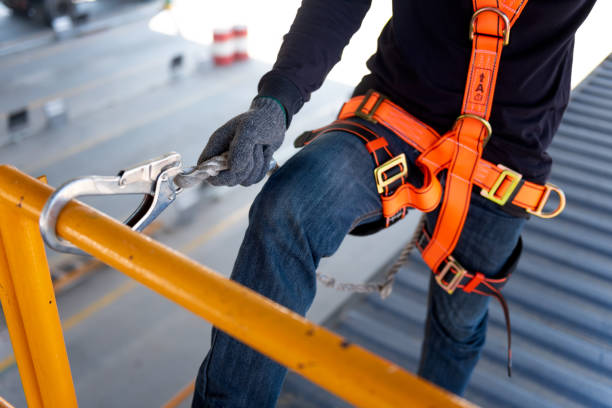Guide To Booking Working At Height Training For New Construction Workers
Working at height training for new construction workers is a legal requirement in the UK to ensure site safety and prevent accidents. This training provides essential knowledge on fall protection, equipment usage, and risk management, helping workers stay safe while operating at height. Without proper training, workers and businesses face serious risks, including injuries, fines, and legal issues.
Booking working at height training for new construction workers is a straightforward process, but it is important to choose an accredited provider that meets UK safety regulations. Approved courses cover key safety procedures such as ladder and scaffold use, harness fitting, fall prevention, and emergency response techniques. The right training ensures that workers understand how to handle tasks safely, reducing the risk of falls and improving overall site safety.
Employers are responsible for ensuring that new construction workers complete this training before working at height. Certification is often required before starting a job, and many companies will not allow workers on-site without proof of completion. Training courses vary in length and format, but most involve classroom learning and practical hands-on exercises to help workers gain real-world skills.
In this guide, we will explain:
- Why working at height training is important
- How to choose the best training provider
- The step-by-step process to book a course
- What to expect during the training
If you need to book work at height training for new construction workers, this guide will provide everything you need to know to make the right choice and ensure compliance with UK safety standards.
Why Working At Height Training For New Construction Workers Is Important
Height training for new construction workers is essential for maintaining safety and ensuring compliance with UK regulations. Falls from height are one of the leading causes of workplace injuries in the construction industry, making proper training a legal and practical necessity. Without the right knowledge and safety measures, workers are exposed to unnecessary risks that could result in serious accidents, project delays, and even legal consequences for employers.
1. Preventing Falls and Injuries: Construction work often involves tasks performed at height, such as scaffolding, roofing, and ladder use. Without proper training, workers may not understand how to use fall protection systems correctly, leading to a higher risk of falls. Training teaches new workers how to use safety harnesses, secure ladders, and identify potential hazards, reducing the likelihood of injuries.
2. Ensuring Legal Compliance: In the UK, The Work at Height Regulations 2005 require all workers operating at height to receive proper training. Employers must ensure that their staff can demonstrate competence before carrying out any work that involves ladders, scaffolding, or elevated platforms. Failure to comply with these regulations can lead to fines, legal penalties, and worksite shutdowns.
3. Increasing Workplace Productivity: When workers are trained in height safety best practices, they work more efficiently and with greater confidence. Proper training helps reduce workplace accidents, disruptions, and costly downtime caused by preventable incidents. A well-trained workforce is more productive because workers spend less time worrying about risks and more time focusing on their tasks.
4. Protecting Employers from Liability; If an accident occurs due to improper safety measures, the employer could be held responsible. Compensation claims, legal fees, and reputational damage can be severe consequences of failing to provide the necessary training. Investing in proper working at height training not only safeguards workers but also protects businesses from costly liabilities.
5. Meeting Industry Requirements: Many construction companies will not allow new workers on-site without proof of working at height training. Certification ensures that workers meet industry standards, making them more employable and allowing them to start work immediately.
Working at height training is not optional, it is a necessity for anyone entering the construction industry. Investing in proper training for new construction workers ensures a safer, legally compliant, and more productive workplace.

How To Choose The Best Working At Height Training For New Construction Workers
Choosing the right height training for new construction workers is essential to ensure safety, legal compliance, and proper skill development. Not all training providers offer the same quality of instruction, so it is important to select a course that meets UK safety regulations and provides workers with the knowledge they need to operate safely at height.
1. Look for Accreditation and Certification
A reliable training course must be accredited by recognised UK safety organisations such as:
- CITB (Construction Industry Training Board)
- IOSH (Institution of Occupational Safety and Health)
- NEBOSH (National Examination Board in Occupational Safety and Health)
- HSE (Health and Safety Executive) Approved Training Providers
Accredited courses ensure compliance with The Work at Height Regulations 2005 and provide workers with legally recognised certification upon completion. This certification is often a requirement for construction sites across the UK.
2. Check Course Content and Practical Training
A well-structured training course should include:
- UK legal requirements and employer responsibilities
- How to assess risks before working at height
- Correct use of fall protection equipment such as harnesses, lanyards, and guardrails
- Safe usage of ladders and scaffolding
- Emergency response procedures and fall rescue techniques
The best courses provide practical hands-on training so workers can experience real-life scenarios rather than just classroom-based learning. A provider that offers practical experience ensures that workers are fully prepared for height-related tasks.
3. Consider Training Duration and Flexibility
Courses vary in duration, typically lasting half a day to two days. Some providers offer on-site training, which allows businesses to train multiple workers at once, while others offer classroom-based or online theory sessions followed by practical assessments. Select a course that matches the availability of your workforce and provides full certification upon completion.
4. Read Reviews and Testimonials
Before booking, it is essential to check reviews and testimonials. Look for feedback on:
- Instructor expertise and experience
- Course structure and clarity
- Hands-on training opportunities
- Ease of booking and customer support
A provider with positive reviews is more likely to deliver a high-quality training experience.
5. Compare Costs and Value for Money
The cheapest course is not always the best. Compare providers based on:
- What is included in the price (certification, PPE use, training materials)
- Hidden costs such as retest fees or certification renewal charges
- The long-term value of a well-trained workforce that reduces accident risks
Selecting the best working at height training for new construction workers ensures safety, compliance, and efficiency. By choosing an accredited provider with strong reviews, hands-on training, and flexible scheduling, businesses can invest in a safer and legally compliant workforce.

